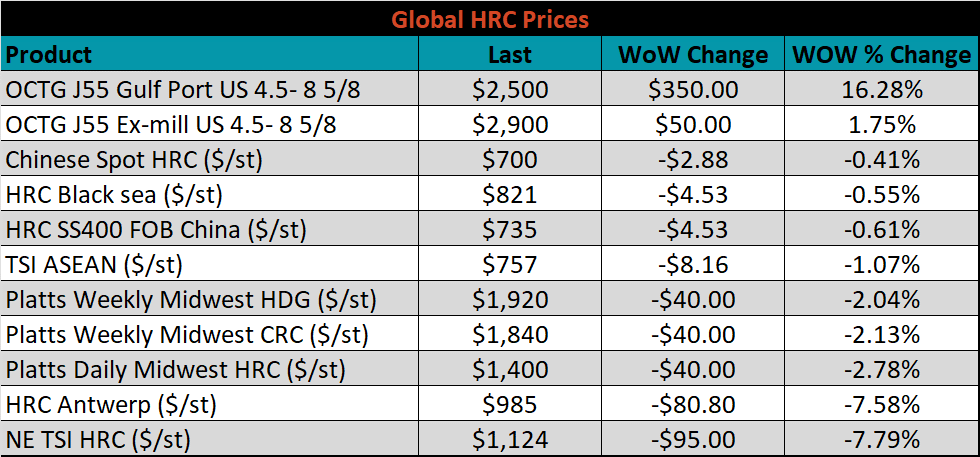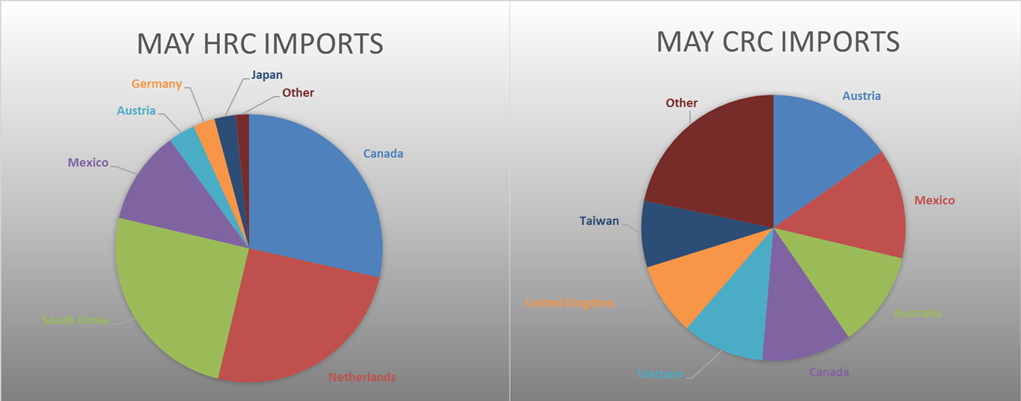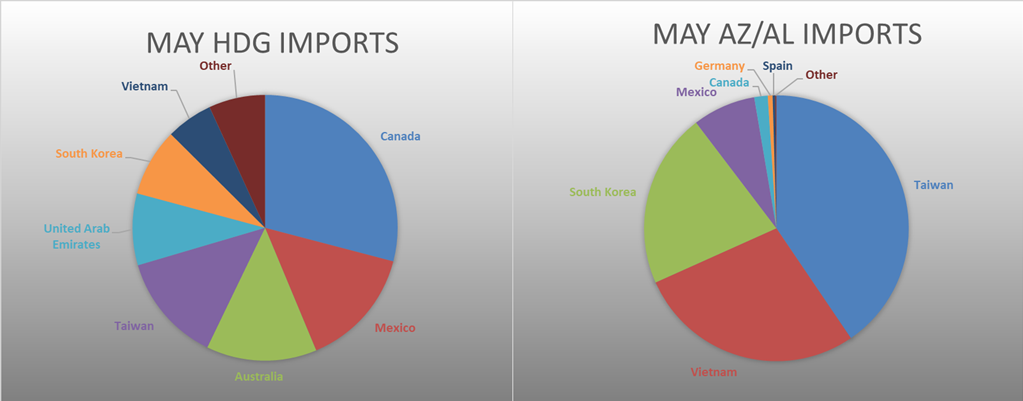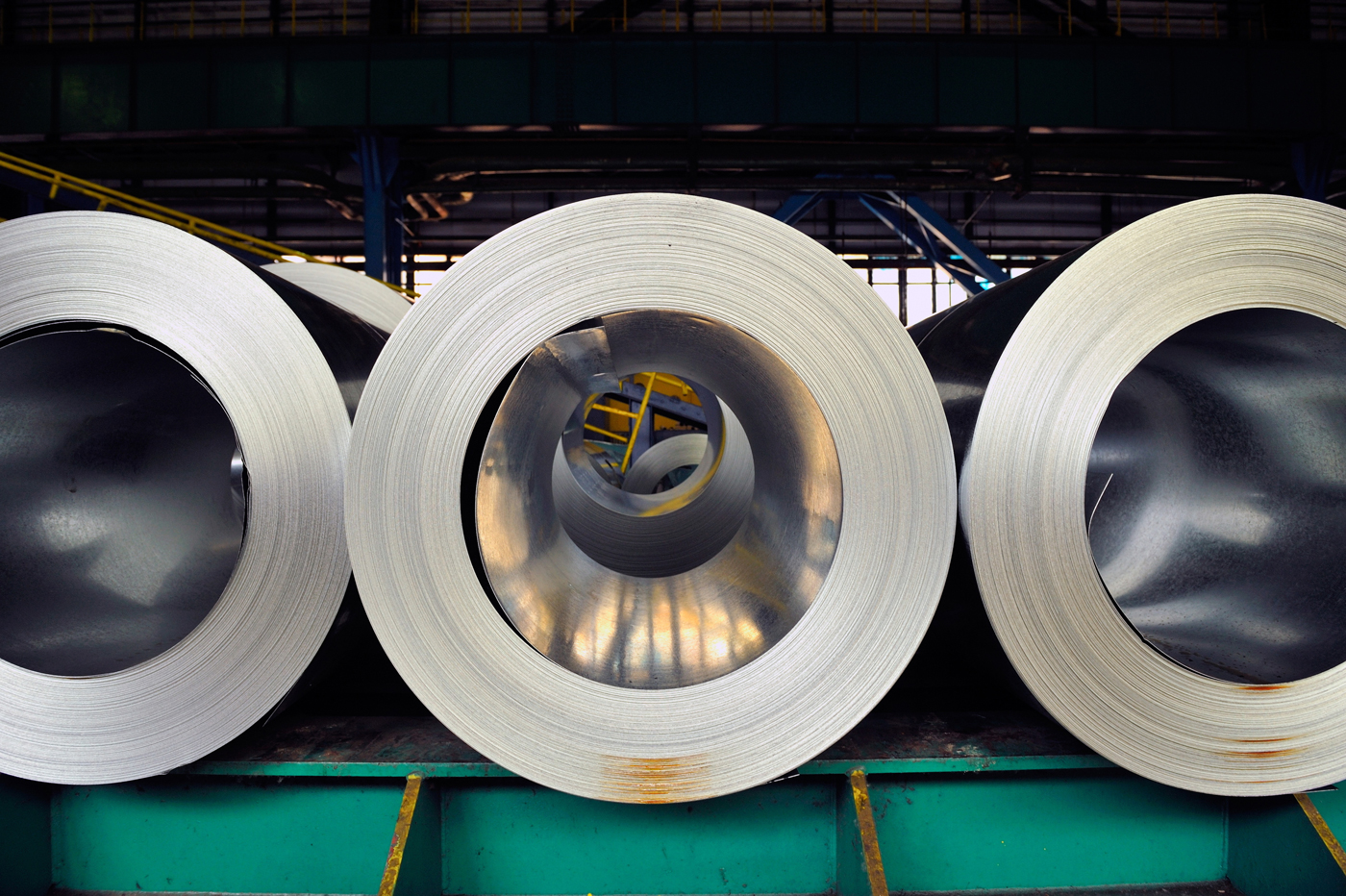

Market Commentary
Downward pressure intensified this week in the physical steel market, as the overall risk-off sentiment across all assets in financial markets and fear of inflation is starting to damage the growth outlook in the U.S. In this regard, one of the most important pieces of news occurred on Wednesday May 4th when the Federal Reserve announced a 50-bps rate hike and signaled that they will continue to hike interest rates until inflation recedes. While this decision was expected, it does officially signal a paradigm shift going forward, where price control will be prioritized over employment which will be a headwind for growth. Our view is that demand for steel in the U.S. and the economy writ-large will hold up better than the rest of the world. We anticipate strong demand within the energy sector (realized by the significant increase in OCTG pricing, this month) and stable growth from the construction and manufacturing sectors industry, as shown in the economic data below. However, this does not mean that steel prices will remain elevated in the coming weeks. We anticipate a trend lower in price but view unsustainably low inventory levels for finished goods, and raw materials as upside risk against a prolonged grind lower in prices.
Outside of the U.S., the shutdowns in China continue to be a major drag on demand in the global market. While stimulative policy measures have already taken place, it will take some time for the impact to follow through once the restrictions are finally removed. On top of that, one of the potential unintended consequences of China’s return will be an incredible increase of exports, which will put even more pressure on a global supply chain and ports that are already stretched historically thin. The combination of these risks has resulted in consolidation of the back of the forward curve around the $1,000 level, which is nearly back to pre-invasion levels. While the forward curve is not a predictor of price, weaker sentiment driven by macro headwinds and structural shifts in Fed policy have been outweighing supportive fundamentals.

ISM PMI
The chart below is the Platts Midwest HRC index (orange) and the ISM Manufacturing PMI (white). The topline ISM Manufacturing PMI index was lower but remains in expansion territory, while the Midwest HRC price leveled off in April.

The April ISM Manufacturing PMI and subindexes are below.

The overall takeaway from this report is that demand from the manufacturing sector continues to grow. The first chart shows the sum of the new order and backlog subindexes, both have been in expansion territory for 23 and 22 months, respectively, while the rate of change is slowing. Additionally, customer inventories, while increasing last month continue to be far too low to support that sustained growth in demand. At the same time, there are two important factors that are restraining the sector, those are supplier deliveries and employment. The second chart shows the supplier deliveries subindex which continues to be historically high and has been trending higher since the end of last year. Additionally, the employment subindex saw the most significant negative move compared to March levels. We have viewed supply chain restriction and difficulty filling open positions in terms of pent-up demand. However, indefinite, sustained pressure will result in some demand destruction.
ISM Manufacturing PMI New Orders + Backlog

ISM Manufacturing PMI Supplier Deliveries

The table below shows the historical values of each subindex over the last year.


Global PMI
April global PMI printings depict another month of an overall expanding global manufacturing sector; however, headwinds continue to drag on the rate of growth. 17 of the 22 watched countries saw their respective manufacturing industries grow, while China fell deeper into contraction territory.

J.P. Morgan Global Manufacturing

Eurozone (white), German (orange), Italian (green), Spanish (red), and French (blue), U.K. (teal) Manufacturing PMIs

US (white), Euro (blue), Chinese (red) and Japanese (green) Manufacturing PMIs

The Caixan and Chinese official PMI indexes both printed sharply lower for the second month in a row, as the country continues to experience pandemic shutdowns and stifled economic activity.
China Official (white) and Caixan (red) Manufacturing PMIs

The table below breaks down China’s official manufacturing PMI subindexes. The stock of finished goods was the only subindex to increase, while supplier delivery times were the most negatively impacted.


Construction Spending
March seasonally adjusted U.S. construction spending was up 0.1% compared to February, and 11.8% higher than March 2021.
March U.S. Construction Spending

The white line in the chart below represents not seasonally adjusted construction spending in 2022 and compares it to the spending of the previous 4 years. The two bottom charts below show the YoY changes in construction spending. Both residential and non-residential spending continue to grow but at a slightly slower pace than last month.
U.S. Construction Spending NSA

U.S. Private Nonresidential Construction Spending NSA YoY % Change

U.S. Residential Construction Spending NSA YoY % Change


Auto Sales
April U.S. light vehicle sales rebounded to a 14.3m seasonally adjusted annualized rate (S.A.A.R) yet they remain well below the 10-year average of 16.2m. The second chart shows the relationship between the unemployment rate and auto sales. The unemployment rate is inverted to show that declining unemployment typically leads to increasing auto sales. The labor market remains strong, and the unemployment rate was unchanged. The gap between auto sales and the labor market continues to be historically wide and constrained by supply chain shortages.
April U.S. Auto Sales (S.A.A.R.)

April U.S. Auto Sales (orange) and the Inverted Unemployment Rate (white)


Risks
Below are the most pertinent upside and downside price risks:
Upside Risks:
- Inventory at end users and service centers below normal operational levels
- Higher share of discretionary income allocated to goods from steel intensive industries
- Unplanned & extended planned outages, including operational issues leaving mills behind
- Seasonal pick-up in demand leading to regional shortages
- Further increases to mills input costs
Downside Risks:
- Elevated price differentials and hedging opportunities leading to sustained higher imports
- Steel consumers substitute to lower cost alternatives
- Tightening credit markets, as elevated prices push total costs to credit caps
- Limited desire to restock at elevated prices, causing a “Buyer’s Strike”
- Economic slowdown caused by increasing interest rates

HRC Futures
All of the below data points are as of May 6, 2022.
The Platts TSI Daily Midwest HRC Index was down another 40 to $1,400.
Platts TSI Daily Midwest HRC Index

The CME Midwest HRC futures curve is below with last Friday’s settlements in white. Overall, the curve moved lower in the front and higher in the back. After 6 weeks of downward pressure, the result of the movement led to a flattening curve just below the $1,100 level.

June ferrous futures were mixed last week. Midwest shredded lost 13.1%, while Midwest busheling gained 9.7%.

Global flat rolled indexes were mostly lower, led by Northern European HRC, down another 7.8%. Domestic OCTG, however increased sharply, with Gulf Port delivered, up 16.3%.

The AISI Capacity Utilization was down 0.4% to 81.3%.

AISI Steel Capacity Utilization Rate (orange) and Platts TSI Daily Midwest HRC Index (white)

Imports & Differentials
May flat rolled import license data is forecasting an increase of 118k to 1.04M MoM.
All Sheet Imports (white) w/ 3-Mo. (green) & 12-Mo. Moving Average (red)

Tube imports license data is forecasting an increase of 90k to 513k in May.
All Tube Imports (white) w/ 3-Mo. (green) & 12-Mo. Moving Average (red)

All Sheet plus Tube (white) w/ 3-Mo. (green) & 12-Mo. Moving Average (red)

May AZ/AL import license data is forecasting an increase of 16k to 113k.
Galvalume Imports (white) w/ 3 Mo. (green) & 12 Mo. Moving Average (red)

Below is May import license data through May 4th, 2022.




Below is the Midwest HRC price vs. each listed country’s export price using pricing from SBB Platts. We have adjusted each export price to include any tariff or transportation cost to get a comparable delivered price. Differentials increased for Brazil and Europe, as their prices fell more sharply than in the U.S., the remaining watched countries saw their differentials decrease slightly.

SBB Platt’s HRC, CRC and HDG pricing is below. The Midwest HRC, CRC, & HDG prices were down 2.8%, 2.1%, & 2%, respectively. Outside of the U.S., the Brazilian HRC export price was down the most, -9.2%.




Raw Materials
Raw material prices were all lower, led by Midwest shredded, down 13.1%.

Below is the iron ore future curve with Friday’s settlements in orange, and the prior week’s settlements in green. Last week, the entire curve shifted sharply lower at all expirations, again.
SGX Iron Ore Futures Curve

The ex-flat rolled prices are listed below.






Energy
Last week, the June WTI crude oil future gained another $5.08 or 4.9% to $109.77/bbl. The aggregate inventory level was down 0.4% and crude oil production remains at 11.9m bbl/day. The Baker Hughes North American rig count was up 3 rigs, while the U.S. rig count was up another 7.

June WTI Crude Oil Futures (orange) vs. Aggregate Energy Inventory (white)

Front Month WTI Crude Oil Future (orange) and Baker Hughes N.A. Rig Count (white)




The list below details some upside and downside risks relevant to the steel industry. The bolded ones are occurring or highly likely.
Upside Risks:
- Inventory at end users and service centers below normal operational levels
- Higher share of discretionary income allocated to goods from steel intensive industries
- Changes in China’s policies regarding ferrous markets, including production cuts and exports
- Unplanned & extended planned outages, including operational issues leaving mills behind
- Energy & construction industry rebound
- Easing labor and supply chain constraints allowing increased manufacturing activity
- Mills extending outages/taking down capacity to keep prices elevated
- Global supply chains and logistics restraints causing regional shortages
- A weakening US Dollar
- Fiscal policy measures including a new stimulus and/or infrastructure package
- Fluctuating auto production, pushing steel demand out into the future
- Low interest rates
- Threat of further protectionist trade policies muting imports
- Unexpected and sustained inflation
Downside Risks:
- Increased domestic production capacity
- Elevated price differentials and hedging opportunities leading to sustained higher imports
- Steel consumers substitute to lower cost alternatives
- Steel buyers and consumers “double ordering” to more than cover steel needs
- Tightening credit markets, as elevated prices push total costs to credit caps
- Supply chain disruptions allowing producers to catch up on orders
- Limited desire to restock at elevated prices, causing a “Buyer’s Strike”
- Economic slowdown caused by the emergence of Coronavirus Variants
- Reduction and/or removal of domestic trade barriers
- Political & geopolitical uncertainty
- Chinese restrictions in property market
- Unexpected sharp China RMB devaluation




















